Recommender systems are widely implemented in E-commerce websites to assist customers in finding the items they need. A recommender system should also be able to provide users with useful information about that might interest them. The ability of promptly responding to changes in user’s preference is a valuable asset for such systems. The recommender system presents an innovative recommender system for music data that combines two methodologies; the content based filtering technique and the interactive genetic algorithm. The recommender system analyzes and recommends items that are appropriate with their own favorites. The recommender system provides recommendation by collecting user’s profiles and discovers relations between each profile. Today increasing numbers of people are turning to computational recommendersystems. Emerging in response to the technological possibilities and human needs created by the World Wide Web, these systems aim to mediate, support, or automate the everyday process of sharing recommendations. The main goal is to identify challenges and suggest new opportunities.
Keywords |
| Recommender System, User’s preference, Music Extraction ,Interactive genetic algorithm, Content
based filtering |
INTRODUCTION |
| When users browse through a web site they are usually looking for items they find interesting. Interest items can
consist of a number of things. For example, textual information can be considered as interest items or an index on a
certain topic could be the item a user is looking for.Another example, applicable for a web vendor, is to consider
purchased products as interest items. Whatever the items consist of, a website can be seen as a collection of these
interest items. Recommender systems are widely implemented in E-commerce websites to assist customers in finding
the items they need.A recommender system should also be able to provide users with useful information about the item
that interest them. The ability of promptly responding to the changes in user’s preference is a valuable asset for such
systems. |
| A Recommender system for music data it proposed which assists customers in searching music data and provides result
with items resulting in own user preference. This system first extracts unique properties of music like pitch, chord, and
tempo from the music file using MARSYAS software. This extracted data is then stored on the database. Each stored
property is analyzed using content Based filtering and interactive genetic algorithm. After acquiring records, the system
recommends items Appropriate to user’s own favorite. |
| When we need to make a decision we often seek out the opinions of others. This is not only true for individuals but also
true for organizations .The goal is to design a recommender system on music domain. The system will be composed of
server side components and client side components. The server-side component will manage the database operations
and algorithms that produce recommendation results. The client-side components will be graphical interfaces that are
integrated into corresponding larger systems. |
What is Recommender system |
| Recommender systems or recommendation systems are a subclass of information filtering system that seek to predict
the 'rating' or 'preference' that a user would give to an item (such as music, books, or movies) or social element
(e.g. people or groups) they had not yet considered, using a model built from the characteristics of an item (contentbased
approaches). |
| Recommendation Systems forms a specific type of information filtering technique that attempts to present information
items. (like movies, music, books, news, images, etc.) |
| A Recommender system for music data is proposed which assists customers in searching music data and provides
result with items resulting in own user preference. Recommender systems have become extremely common in recent
years.[1] |
What is Content based filtering |
| A common approach when designing recommender systems is content-based filtering. Content-based filtering methods
are based on information about and characteristics of the items that are going to be recommended. In other words, these
algorithms try to recommend items that are similar to those that a user liked in the past (or is examining in the present).
In particular, various candidate items are compared with items previously rated by the user and the best-matching items
are recommended. |
| >> key issue with content-based filtering is whether the system is able to learn user preferences from user's actions
regarding one content source and use them across other content types. When the system is limited to recommending
content of the same type as the user is already using, the value from the recommendation system is significantly less
than when other content types from other services can be recommended.[3]. |
RELATED WORK |
Recommender Systems |
| The main issue of a recommender system is how to recommend items tailored with user’s preference from resources.
The recommender system also has to recognize and provide this matter, there are two main approaches: |
| Content based filtering and Collaborative filtering |
| • In the collaborative filtering approach, the recommender system provides recommendation by collecting user’s
profiles and discovers relation between each profile. After identifying correction of each profile, the system classifies
users having profiles that are similar to the others. The system then recommends items derived from other profiles in
the same group. |
| • Collaborative filtering |
| The advantage of this approach, thus is that it has a high possibility to recommend items corresponding with user’s
preference by providing environments in each user can share his or her profile. |
Music Extraction |
| The feature extraction is a technique that derives properties from specific data, such as music, document and photo. It
also useful for grouping statics resources. In our proposed system, it employ the content based filtering to acquire
information from music data. The analysis of item is an essential step of filtering items in the content based filtering
approach. We then use a Feature extraction tool (MARSYAS) to analyze the properties of items. |
| The software framework for research and application development on the audio and music domain, The
MARSYAS Software provides complex audio signal analysis, transformations and synthesis. |
Interactive genetic algorithm |
| Genetic Algorithm (GAs) are stochastic search methods inspired from the mechanism of natural evolution and genetic
inheritance. Gas work on a population of candidate solutions; each solution has a fitness value indicating its closeness
to the optimal solutions of the problem. The solution having higher fitness values than others are selected and also
survive to the next generation. GAs then produce better offspring by the combination of selected solutions. The
methods can discover preserve and propagate promising sub-solutions. |
GENETIC ALGORITHM |
| Introduction of GA: |
| The evolutionary process of a GA is a highly simplified and stylized simulation of the biological version. It starts from
a population of individuals randomly generated according to some probability distribution, usually uniform and updates
this population in steps called generations. Each generation, multiple individuals are randomly selected from the current
population based upon some application of fitness, bred using crossover, and modified through mutation to form a new
population. |
Genetic algorithm procedure: |
| 1. Choose the initial population of individuals |
| 2. valuate the fitness of each individual in that population |
| 3. Repeat on this generation until termination (time limit, sufficient fitness achieved, etc.): |
| 4. Select the best-fit individuals for reproduction |
| 5. Breed new individuals through crossover and mutation operations to give birth to offspring |
| 6. Evaluate the individual fitness of new individuals |
| 7. Replace least-fit population with new individuals |
| The evolutionary process of a GA is a highly simplified and stylized simulation of the biological version. It starts from
a population of individuals randomly generated according to some probability distribution, usually uniform and updates
this population in steps called generations. Each generation, multiple individuals are randomly selected from the current
population based upon some application of fitness, bred using crossover, and modified through mutation to form a new
population. |
| • Crossover – exchange of genetic material (substrings) denoting rules, structural components, features of a
machine learning, search, or optimization problem. |
| • Selection – the application of the fitness criterion to choose which individuals from a population will go on to
reproduce. |
| • Replication – the propagation of individuals from one generation to the next |
| • Mutation – the modification of chromosomes. |
PHASES OF GENETIC ALGORITHM IN RECOMMENDER SYSTEM: |
| The following are phases of genetic algorithm are as follows: |
| Selection phase – Music features are extracted using MARSYAS software. The items which are rated above
threshold value are selected rest other items are ignored. |
| Crossover phase – The BLX – alpha crossover algorithm is used since extracted features are real numbers.
Hence crossover is performed with this algorithm resulting in new generation. |
BLX-a: |
| Input: |
| 1. Select two parents X(t) and Y(t) from a parent pool |
| 2. Create two offspring X(t+1) and Y(t+1) as follows: |
| 3. for i = 1 to n do |
| 4. di=|xi(t)-yi(t)| |
| 5. Choose a uniform random real number u from |
| 6. interval <min(xi(t),yi(t))-adi, |
| 7. max(xi(t),yi(t))+adi> |
| 8. xi(t+1)=u |
| 9. Choose a uniform random real number u from |
| 10. interval |
| 11. <min(xi(t),yi(t))-adi, max(xi(t),yi(t))+adi> |
| 12. yi(t+1)=u |
| 13. end do |
| 14. where: a – positive real parameter |
Output: |
| • to provide users with useful information about that might interest them. |
| • the system recommends items Appropriate to user’s own favorite. |
| Matching phase- This phase finds the similar items stored in database to the newly Generated music features.
Once similarity is found those items are recommended to the User. |
| This phase uses Euclidean distance between two offspring and distance between Each feature of the two offspring is
calculated, resulting value is used to match the records Stored in the database those records are compared with the
resulting value which the user has given highest rating to the tracks. |
THE EXPERIMENT AND RESULTS |
| The system will display music files from the database based on the ratings given by the user and by applying genetic
algorithm.The recommender system should allow any user to give ratings to the music items. The system will provide
error messages to help direct the users through various options.Once the user has given rating to the music files these
selected files will be stored onto the database. Each user details from profile page are stored directly to the database. |
Implementation |
| The recommended system incorporates with this system, which is implemented in java Servlet page (jsp), the
information gathered in the previous step (feature extraction phase ). After that then build a website provides essential
information such as artist name and song title; The test strategy consists of a series of different tests that will fully
exercise the system. The primary purpose of these tests is to uncover the systems limitations and measure its full
capabilities. Any data item will have certain constraints like, the type of the data, length of the data, unique data and
compulsory data and when getting these data from the user, appropriate tests should be done to ensure that the data item
confirm to the constraints. |
| Each time a user evaluates a page of 10 times. The initial page is randomly successive page is constructed based on the
user evaluation of the preceding one. In order to help user’s evaluation, It provide a function that user can listen to the
music tracks which they are not familiar with. |
Experiment Results |
| The tests will focus on the behavior of the system. User scenarios will be executed against the system as well as screen
mapping and error message testing. Overall, the system tests will test the integrated system and verify that it meets the
requirements. |
| Here we can store unlimited songs file in the database and the local server. The songs page displays 10 music files on
each page. It is based on Simple and Square Euclidean distance. |
| Fig. 5 shows the performance of the proposed recommender system. We did not consider results of the first page since
users tend to rate too much higher values for times on the page than other pages. Beside, the users need to become
familiar with the rating mechanism of our systems. Also , We measured the number of items that were rated over 80 for
each user pages because these items have more impact to trace user preference than others. As seen in the figure, the
average scores gradually improve as the page number proceeds. It denotes that the users were satisfied with the
recommendation made by our system. In other words, The results prove the efficiency of our recommender system in
detecting and tracing the preference of each other.[1] |
CONCLUSION |
| We proposed real-time genetic recommendation method in order to overcome the existing recommendation techniques
that are not reflecting in the current user`s intend. With the genetic algorithm newer solutions can be generated
providing optimal solution each time when the algorithm is made to run, thus providing mutations.
This method can be compared with the existing ones which lack the quality of providing accurate results. |
| |
Figures at a glance |
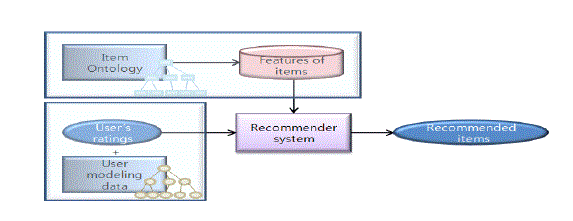 |
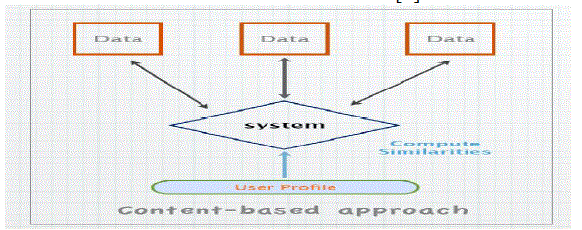 |
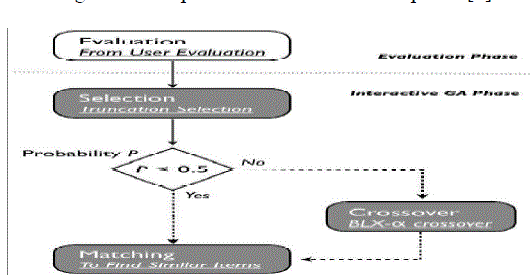 |
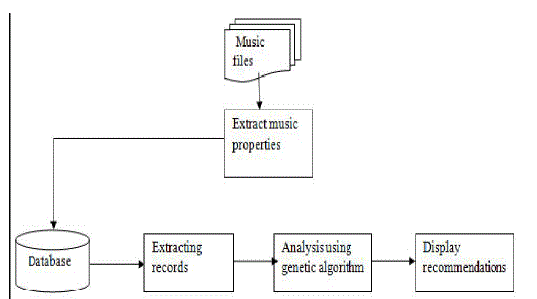 |
| Figure 1 |
Figure 2 |
Figure 3 |
Figure 4 |
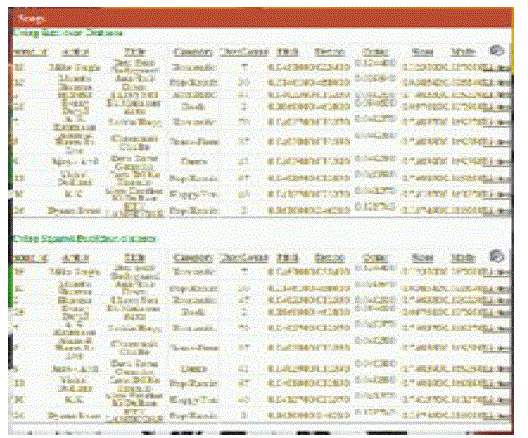 |
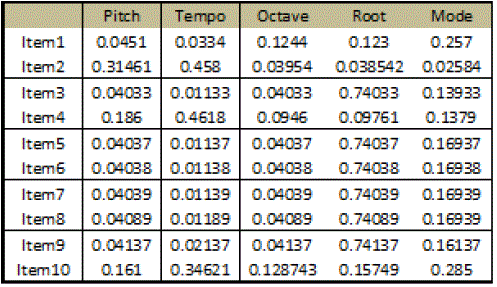 |
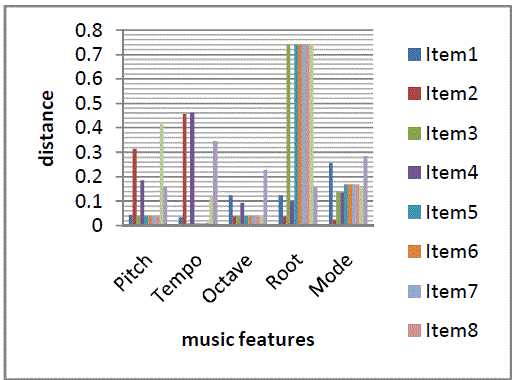 |
| Figure 5a |
Figure 5b |
Figure 6 |
|
| |
References |
- Hyun ? Tae Kim, Eungyeong Kim, ?Recommender system based on genetic algorithm for music data?, 2nd International Conference on Computer Engineering and Technology, 2010.
- J. Ben Schafer, Joseph Konstan, John Riedl,?Recommender Systems in E-Commerce?, 2007.
- D.E Goldberg and J. H Holland, ?Genetic Algorithms and Machine Learning?, 2006.
- Paul resnick and Hal .R. varian,?Recommender system?, Vol. 40, No. 3 COMMUNICATIONS OF THE ACM, March 1997.
- F.Herrera, M.Lozano, and J.L. Verdegay, ? Tackling Real- code Genetic Algorithms ,? Operators and tools for Behaviour Analysis, ? Artificial Intelligence Review, vol.12. pp.265- 319, 2004.
- M.Balabanovic and Y.Shoham, ? FAB : Content Based,collaborativeRecommendation,?communications of the ACM, vol.40, no.3, pp66-72, 2009.
- J.F.Crow and M.Kimura, ? Efficiency of Truncation selection,? in proceeding of the National Academy of science of the United State of America. Vol. 76, no. 1, pp. 396-399,2006.
|